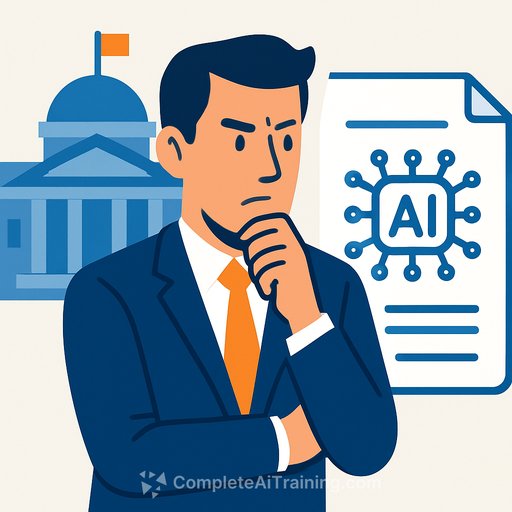Deloitte discovers the dangers of AI content
The professional services giant that once condemned others for AI mishaps has been caught making identical blunders in a taxpayer-funded report.
Even elite firms can misfire with AI-generated content. For government, that risk becomes your risk the moment it appears under your seal.
Procurement can't outsource accountability. If a contractor's AI outputs slip through, you face reputational damage, corrections, and wasted public money.
Why this matters for public agencies
- Public trust: Errors or fabricated citations in official reports spread fast and are hard to correct.
- Legal exposure: Copyright claims, privacy breaches, and false claims can trigger audits, complaints, or litigation.
- Policy consequences: Decisions built on faulty analysis lead to poor outcomes and budget waste.
- Transparency duties: FOI and audit trails demand clear provenance of who wrote what, and how.
Common AI content traps in official reports
- Fabricated or distorted citations: References that look real but don't exist, or misquote sources.
- Out-of-date facts: Models trained on stale data confidently present old numbers as current.
- Plagiarism and weak paraphrase: Near-verbatim text lifted from reports, websites, or news.
- Undisclosed AI use: Stakeholders assume expert analysis; instead, they get unverified machine output.
- Sensitive data leakage: Staff paste internal content into tools that retain or learn from prompts.
- Inconsistent tone and logic: Sections feel stitched together, with contradictions that reviewers miss.
What to require from vendors now
- Disclosure clause: Vendors must declare any AI use in research, drafting, editing, or image generation.
- Provenance logging: Keep prompt logs, model versions, datasets, and who edited what. Deliver with the final report.
- Citation verification: Every reference must be human-checked. No link, no claim.
- Originality guarantee: Written commitment of no plagiarism, with similarity reports on submission.
- Data handling rules: Ban public tools for sensitive material. Use approved, enterprise-grade solutions with retention controls.
- Human-in-the-loop signoff: Named senior reviewer certifies accuracy, sources, and policy compliance.
- Audit rights: Agency can inspect drafts, logs, and source materials on request.
- Indemnity and remedies: Define penalties, fix timelines, and public correction protocols for errors.
- Transparency statement: Include an appendix describing AI assistance and verification steps.
Internal checklist for your team
- Classify the work: High-impact outputs (briefs, public reports) require stricter controls than internal memos.
- Approved tools: Maintain a list of allowed AI systems, versions, and usage rules. Block unapproved tools on network.
- Prompt hygiene: Remove PII and sensitive details from prompts. Use secured redaction where needed.
- Red-team the draft: Task reviewers to challenge claims, check logic, and search for hidden errors or bias.
- Source-first writing: Start from verified data and legislation. Summarize sources before asking an AI to refine language.
- Citation inventory: Maintain a living list of sources with URLs, access dates, and archived copies.
- Plagiarism and similarity scan: Run checks on final drafts before signoff.
- Accessibility and clarity: Ensure plain language, alt text for images, and compliance with accessibility standards.
- Version control and records: Save all drafts and approvals in your records system with timestamps.
- Publication gate: Final release requires named approver, verification checklist, and a corrections plan.
How to respond if an AI content issue surfaces
- Pause distribution: Pull the report, mark the version as withdrawn, and prevent further sharing.
- Issue a correction note: State what went wrong, what is being corrected, and when the update will be published.
- Publish a revision log: Document each fix with sources.
- Notify stakeholders: Brief leadership, comms, and oversight bodies. Offer a summary of impacts.
- Review the vendor: Evaluate contract performance, apply remedies, and decide on future engagement.
- Strengthen controls: Update procurement language, verification steps, and staff training.
Policy anchors to guide your framework
Ground your controls in recognized standards to avoid rework and drift.
- NIST AI Risk Management Framework for governance, measurement, and continuous improvement.
Procurement-ready language you can adapt
- AI Use Disclosure: "Contractor shall disclose all uses of AI systems in the creation of any deliverable and provide detailed provenance logs upon submission."
- Verification Duty: "All factual claims and citations must be verified by a qualified human reviewer employed by the contractor. Verification records shall be delivered with the final artifact."
- Data Protection: "Contractor shall not input sensitive or personal data into public AI tools. Only agency-approved systems with data retention controls may be used."
- Indemnification: "Contractor shall indemnify the agency for damages arising from plagiarism, false claims, or IP violations in the deliverable."
- Audit and Remediation: "Agency reserves the right to audit drafts and logs. Contractor must correct verified issues within five business days at no additional cost."
Practical guardrails for leaders
- Set a default: AI can help with phrasing; humans own facts, structure, and sources.
- Measure what matters: Track correction rates, citation validity, and time-to-fix on vendor work.
- Train for the job: Teach staff and vendors how to prompt safely, verify claims, and keep clean records.
Allegations about flawed AI-assisted reports highlight a simple truth: if the process is weak, the outcome is weak. Your agency can avoid the next headline with clear rules, verifiable sources, and firm vendor accountability.
If your team needs structured upskilling by role, explore focused options here: AI courses by job.
Your membership also unlocks:






